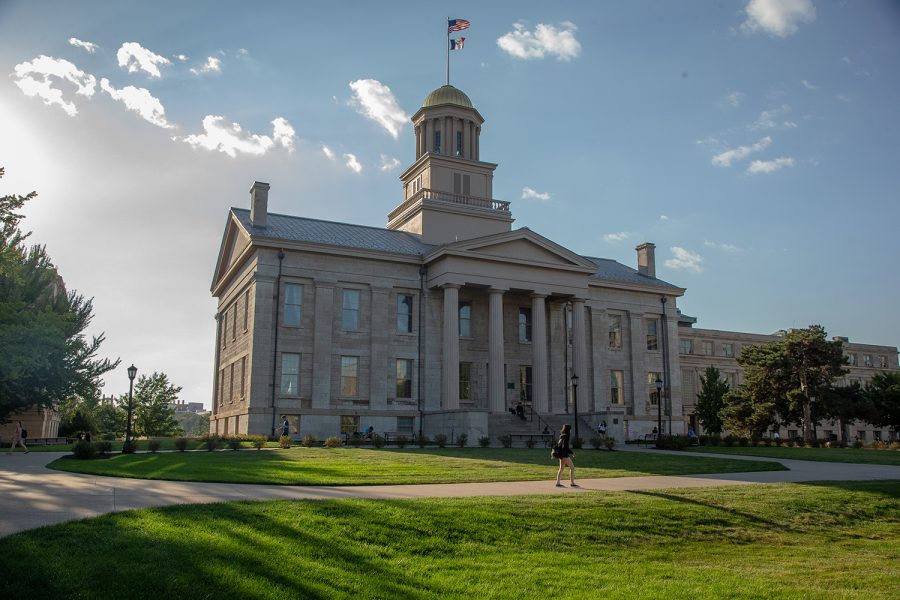UI’s 2020 initiative to bring in ‘big ideas’ met barriers, report says
The initiative to review the university’s structure found barriers to thinking of long-term ideas that would lead the institution in the decades to come.
The Old Capitol building is seen in 2018.
December 11, 2018
A committee tasked with brainstorming “big ideas” for the university’s long-term future concluded several barriers get in the way of imaginative thinking: State funding for Iowa’s universities has declined. The UI has seen administrative turnover in recent years with several positions still vacant. The institution is in the middle of its first fiscal year with a new budget model.
The 2020 initiative to review the institution’s structure ended with the recent release of its final Phase 2 report — months after initially being slated for release in the spring 2018 semester. The report stated that, given the aforementioned barriers, “This was probably not the best time to ask the UI community to think long-term.”
“We do not have a regular and efficient institution-wide process for soliciting, vetting, and funding long-term big ideas that span individual units,” the report stated. “Without such a process, the immense creativity in the UI community will be primarily limited to ideas in individual disciplines, labs, centers, etc., where ideas can be realized. This is, indeed, where much of our creativity should be focused. But we should also have a process that encourages big-idea thinking.”
RELATED: UI striving for perfect foresight in 2020
The initiative stemmed from a charge by former UI Provost Barry Butler, who directed college leadership before his departure in March 2017 to study potential organizational changes that could be made to the UI to enable it to “become a more forward-looking, nimble university that focuses our limited resources in support of academic excellence,” according to a memo sent to administrators and shared-governance leaders Jan. 19, 2017.
A key goal in undertaking the initiative was to help the university community look beyond its near-term future encompassed by the 2016-21 strategic plan and provide “a rare opportunity to imagine collectively what our institution might be in 10 or 20 years and how we might get there.”
Instead, the report noted that much of the ideas that arose from the discussion the initiative generated were focused on the short-term or were big ideas that were “expressed in very general terms” or lacked sufficient detail to implement.
Another problem getting in the way of the Phase 2 committee’s work, according to the report, was the angst surrounding the process, particularly from College of Liberal Arts & Sciences faculty who feared the process would pave the way for dividing the college.
RELATED: Community urges UI to rethink Iowa-centric practices in reorganization
UI President Bruce Harreld said in a statement to The Daily Iowan he thanks the committee working on the initiative for the time and effort invested.
“… It was an inclusive process, and I respect the committee’s conclusion that we need to live with the new budget model for a few years before soliciting, vetting, and recommending big ideas for the future,” he said. “With the successful conclusion of ongoing searches for a provost, vice president for Research, and vice president for Diversity, Equity, and Inclusion, we will certainly continue to consider our future and bring our new leaders into this process.”
Faculty Senate President Russ Ganim said in an email to the DI that the Faculty Senate appreciates the time faculty put into serving on the committee and producing the report, but “time and financial constraints, the implementation of the new budget model, and considerable administrative turnover did not allow for these discussions to produce substantive proposals along these lines.”
“… While the process may not have yielded measurable programmatic results, the Senate recognizes the value of engaging in broad discussions about the future of university, if for no other reason than to make sure shared governance plays a considerable role not only in such conversations but in the decisions that may result from them,” he said.
RELATED: UI community pushes for realistic approach to campus reorganization in public forum
Other universities have undergone similar reviews of their structures to come up with long-term initiatives. The report highlighted such examples as the tuition-reimbursement program between Arizona State University and Starbucks and Purdue University’s purchase of Kaplan University to offer online education tailored to working adults.
“These particular initiatives may not have been right for UI,” the report stated. “But there are big ideas that probably are right for UI, and we should put in place processes to encourage them to be imagined.”






